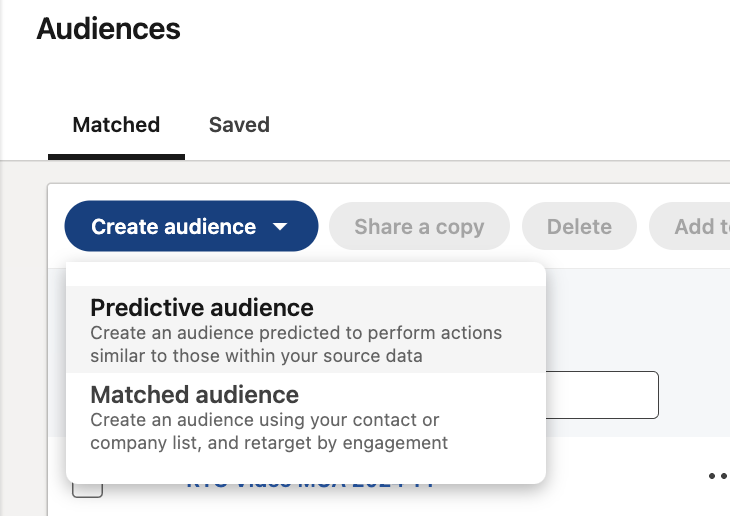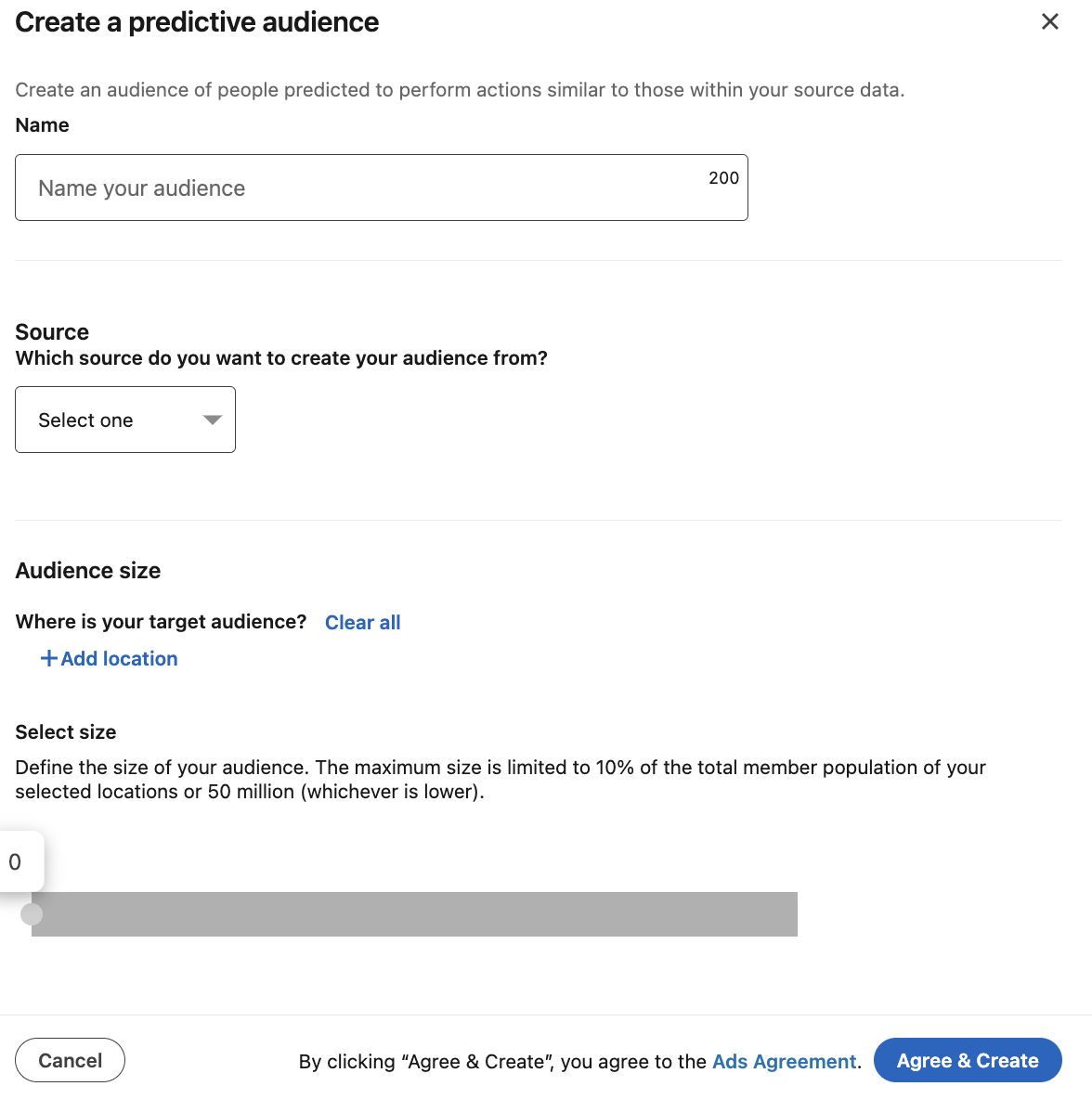Every brand has an ideal customer, right?
So, once you’ve identified yours, you can understand and then fully utilise the concept of LinkedIn Lookalike audiences (now called Predictive Audiences) to further boost your lead generation success with LinkedIn advertising.
When doing so, a brand’s target leads need to meet a certain criteria in order to qualify as a “potential customer”. If you’re wondering what the criteria is, it’s this:
– Need – does the lead have a need that your product or service is able to fulfil?
– Interest – is the lead interested in fulfilling that specific need?
– Budget – does the lead have enough money to make the purchase?
If you’ve ticked ‘yes’ for each specific one and are leaping for joy – hold up a second. Not to rain on your parade, but this doesn’t automatically mean they’re going to open their wallets to you. This is just the basic, starting criteria. A criteria foundation, if you will.
To fully delve into all the specifics of audience criteria on a more extensive level, you also need to incorporate the following.
– Geographical area – if they need to go to a physical shop to buy your product, are they able to easily and locally do so?
– Timing – perhaps they are the right lead in every way, but if the purchase in question is timing-dependent and the timing isn’t right, they might hold off.
– Decision-making authority – are you targeting the right people at the right companies? Aiming for individuals who possess the power to make purchasing decisions is important.
– Professional profile – this can be especially important for some businesses/leads, and can be dependent on their levels of experience in conjunction with the product/service you’re selling.
Case Study: How We Helped a Security Analytics Software Company Generate 42% More SQLs Using LinkedIn Ads
Key Takeaways
– Start with Quality Data Sources: Use your best-performing contact lists, retargeting audiences, or Lead Gen form responses as the foundation. The better your source data, the more effective your Predictive Audience will be.
– Expect Higher Engagement, Higher Costs: Predictive Audiences typically deliver better engagement rates than standard targeting, but CPMs are usually higher. Factor this into your budget planning.
– Minimum Scale Requirements Matter: You need at least 300 contacts in your source audience before LinkedIn can create an effective Predictive Audience. Plan your data collection accordingly.
1 – What Are LinkedIn Predictive Audiences?
So, now you’ve narrowed down the specifics of your LinkedIn audience by examining the correct criteria, let’s look at what LinkedIn Predictive audiences actually are.
Now that you’ve established the audience fundamentals, creating a Predictive audience will be easier and will have a higher chance of conversion success.
And here’s where LinkedIn fits into the equation.
LinkedIn will do most of the legwork for you. How LinkedIn Predictive Audiences works is it combines the traits and behavioural patterns of your current leads/customers/website visitors with data it has plucked in order to identify other LinkedIn users with similar characteristics, who in turn, are more likely to be converted.
Your LinkedIn ad campaigns will garner attention and interest via engagement and website clicks, etc., and where LinkedIn Predictive Audiences flicks its magic wand is it’ll sift through all of those members and establish who actually qualify as your target audience (AKA, who is likely to convert) and those who don’t actually meet any (or enough) of the criteria (AKA, who isn’t likely to convert), with the goal being making your targeting much more precise and effective.
If you’re familiar with the way LinkedIn ad campaigns work via targeting through the site’s algorithm, you’ll have likely already used the LinkedIn matched audience and uploaded lists of email contacts and other targeted companies who you want to see a campaign. So with this in mind, LinkedIn is able to identify key decision-makers who have an appropriate job function (such as Business Development, for example) and who are more likely to engage and be converted.
Where Predictive Audiences comes in is it can create a similar audience of users that all have the job function of Business Development (or something similar), meaning it’ll mirror your original audience. Clever, huh?
2 – What Are The Benefits of Predictive Audiences?
So, getting involved with Predictive Audiences provides multiple benefits, such as:
– It will help you scale your campaign quickly, easily, and effectively.
– It will help you find new high-quality leads.
– It will maximise your ROI because specific targeting enhances the likelihood of conversion.
– It allows you to create the matched audience segment, giving you more control.
– It will help you reach potential leads that are similar to your best customers, which is almost guaranteed success!
3 – How Do I Create a Predictive Audience on LinkedIn?
Good news – creating a Predictive Audience on LinkedIn is actually really simple because LinkedIn does all the complicated, techy stuff for you. But here’s how to get the ball rolling:
– Head to your Campaign Manager
– Click on the account that you want to work with
– Go to Account Assets – Matched Audiences.
– Click on the blue button Create Audience
– Select predictive audience from the dropdown.

– Choose the source audience for your Predictive Audience. Name your audience and click “Create”
Note: You’ll need existing audiences to create Predictive Audiences from.

4 – What Sources Can I Use For My Predictive Audience?
You’ll need to follow this step-by-step guide, so pay attention! Here are your sources:
4.1 – A list of target accounts or contacts
This source allows you to provide LinkedIn with a database of emails/accounts that you’ve previously collected in your CRM. LinkedIn will then use this information to match against its own database of users to find similar accounts.
An example:
Your lead has used one email address to register for your website, and the same one for creating his/her LinkedIn profile, right? Good. LinkedIn considers this as a correct match. Whoop! It will then analyse the info here to find similar profiles.
“What happens if they use a different email address?” we hear you say.
Good question, because of course, this does happen. If the email address doesn’t match, LinkedIn doesn’t consider them as the same person, meaning it can’t analyse the data you are requesting.
The important part of this process is that LinkedIn identifies and matches the person who left their email on your website to the person who shares their name on LinkedIn. Without this, there’s no real guarantee they’re the same person.
Creating a Predictive audience from a CRM Database
To do this, you’ll need to go to your Campaign Manager on LinkedIn. If you don’t have a contact or an account list yet, you will need to create one first. Here’s how to do that:
– Select the account name in which you want to upload your list (in case you have various accounts).
– Go to Account Assets -> Matched Audiences
– Click on Create Audience from the upper right corner
– From the dropdown, select Upload a list – Company / Contact.
– Download the .csv template, and paste your audience emails, or in the case of company accounts, the list of Company pages that you want to target in LinkedIn.
– Either go to Create Audience – Lookalike and find it there, or directly select Create Predictive from the three dots next to the audience.

You can also create Predictive audiences from any other lists of contacts that you have, just keep in mind that it must comply with the GDPR rules (if you are in Europe), and with the corresponding privacy regulations outside of Europe.
Case Study: How We Helped Kodo Survey to Generate 167% More Leads in 3 Months Using LinkedIn Ads
4.2 – Predictive audience from a retargeting audience
You can also build your Predictive audience from a pre-existing audience you may have from a retargeting campaign, as per Facebook or Google, meaning by collecting cookies from users coming to your website from your LinkedIn campaigns.
Once you’ve created a retargeting audience, LinkedIn will start collecting cookies from users who clicked on your campaigns and landed on your website. This allows you to build an audience based on users who are already familiar with your brand. This works well because the Predictive audience will naturally mirror those users.
Creating a Predictive from a retargeting audience
For Predictive audiences based on retargeting audiences you’ll need to build a retargeting audience list first – and it’ll need to have a minimum of 300 leads. You will be able to create a total of four retargeting audiences:
– Events audience – to re-engage with people who signed up for your LinkedIn live events in the past.
– Company audience – you can also impact people who have interacted with your Company page in the past.
– Video audience – to re-impact people who have watched your sponsored videos on LinkedIn in the past.
– Website – allowing you to impact people who have visited your website from your campaigns in the past.
Once this is done, simply follow the exact same step as above to create your Predictive audience.
4.3 – Predicitve from a Lead Gen form
Lead Gen forms are LinkedIn’s own forms that you can configure to open for your audience, instead of driving them to your website once they’ve clicked on your ad. How it works is the forms automatically extract information from a user’s profile, reducing the time and hassle for users who want to leave their personal data in an uncomplicated way, or without having to visit a third-party website to do so. Our B2B LinkedIn ads agency always recommend using Lead gen form over landing pages.
For this method, you’ll need to create a lead gen form. Here’s how:
– Go to Account Assets
– Click on Lead Gen forms
– Click on Create Form, and start configuring your form by adding the data that you want to request from your audience.

Once you’ve created your form and generated enough volume of leads (300, minimum), you can create your LinkedIn Predicitive audience in the same way as mentioned above.
Expert Tips for Success
– Always layer with ICP filters: Don’t rely solely on Predictive Audiences. Add job title, seniority, and company size filters to ensure you’re reaching the right decision-makers within similar companies.
– Use proven data sources: Prioritize leads, contact lists, or conversion data from your CRM. These represent people who’ve already shown genuine interest in your solution.
– Promote tested offers: Stick with assets and offers that have already proven successful with native targeting. Predictive Audiences amplify what works – they don’t fix poor offers or messaging.
Conclusion
So, we hope this has provided invaluable insight into the wonderful world of LinkedIn Predictive Audiences and how to create yours to smash those lead gen targets!
If you’d like to learn more about how we help B2B SaaS and Tech companies grow their MRR through LinkedIn advertising, contact us online or send us an email today at info@getuplead.com to speak with someone on our team.
You might also be interested:


